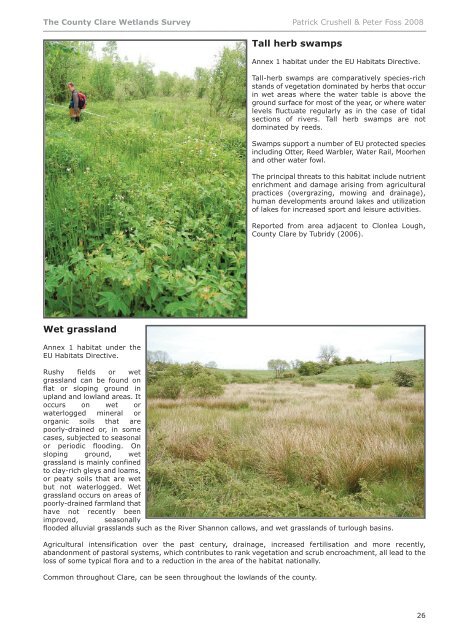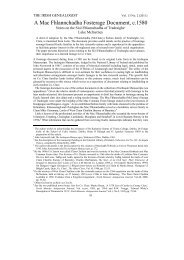Report Cover Vol I - Clare County Library
Report Cover Vol I - Clare County Library
Report Cover Vol I - Clare County Library
Create successful ePaper yourself
Turn your PDF publications into a flip-book with our unique Google optimized e-Paper software.
The <strong>County</strong> <strong>Clare</strong> Wetlands Survey Patrick Crushell & Peter Foss 2008<br />
___________________________________________________________<br />
Tall herb swamps<br />
Annex 1 habitat under the EU Habitats Directive.<br />
Tall-herb swamps are comparatively species-rich<br />
stands of vegetation dominated by herbs that occur<br />
in wet areas where the water table is above the<br />
ground surface for most of the year, or where water<br />
levels fluctuate regularly as in the case of tidal<br />
sections of rivers. Tall herb swamps are not<br />
dominated by reeds.<br />
Swamps support a number of EU protected species<br />
including Otter, Reed Warbler, Water Rail, Moorhen<br />
and other water fowl.<br />
The principal threats to this habitat include nutrient<br />
enrichment and damage arising from agricultural<br />
practices (overgrazing, mowing and drainage),<br />
human developments around lakes and utilization<br />
of lakes for increased sport and leisure activities.<br />
<strong>Report</strong>ed from area adjacent to Clonlea Lough,<br />
<strong>County</strong> <strong>Clare</strong> by Tubridy (2006).<br />
Wet grassland<br />
Annex 1 habitat under the<br />
EU Habitats Directive.<br />
Rushy fields or wet<br />
grassland can be found on<br />
flat or sloping ground in<br />
upland and lowland areas. It<br />
occurs on wet or<br />
waterlogged mineral or<br />
organic soils that are<br />
poorly-drained or, in some<br />
cases, subjected to seasonal<br />
or periodic flooding. On<br />
sloping ground, wet<br />
grassland is mainly confined<br />
to clay-rich gleys and loams,<br />
or peaty soils that are wet<br />
but not waterlogged. Wet<br />
grassland occurs on areas of<br />
poorly-drained farmland that<br />
have not recently been<br />
improved, seasonally<br />
flooded alluvial grasslands such as the River Shannon callows, and wet grasslands of turlough basins.<br />
Agricultural intensification over the past century, drainage, increased fertilisation and more recently,<br />
abandonment of pastoral systems, which contributes to rank vegetation and scrub encroachment, all lead to the<br />
loss of some typical flora and to a reduction in the area of the habitat nationally.<br />
Common throughout <strong>Clare</strong>, can be seen throughout the lowlands of the county.<br />
26
















